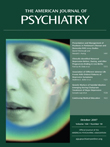Traumatic Dissociation: Neurobiology and Treatment
The term “dissociation” refers to the splitting apart of streams of consciousness, psychological processes, or personality structures that would normally form a cohesive whole (1) . Dissociative phenomena cut across multiple axis I and II DSM-IV-TR disorders. Several conditions explicitly include dissociative symptoms, notably dissociative amnesia, dissociative fugue, dissociative identity disorder, and borderline personality disorder. In others, a relationship with dissociation has been suggested by the literature but is not explicitly mentioned by DSM. For example, peritraumatic dissociation has been shown to predict the later development of posttraumatic stress disorder (PTSD) (2) . Trichotillomania has been linked to childhood trauma, and repetitive hair pulling is often undertaken in a state of dissociation (3) . Therefore, our understanding of the relationship between dissociation, trauma, and psychopathology is very important clinically (4 – 7) . In their welcome book, Eric Vermetten and co-editors bring together contributions from a variety of experts in order to chart the ascent of traumatic dissociation, beginning with Piaget and Freud, moving on to DSM, and thence the neurosciences, translational medicine, contemporary controversy, and treatment.
The book comprises three overarching sections. The first probes conceptual and historical issues surrounding dissociation, such as a potential role for disorganized attachment during childhood (e.g., frightening and abusive behavior from parents) as a vulnerability factor for dissociative psychopathology in later life. Traditionally, dissociative identity disorder (a contentious entity at the best of times) has been conceptualized in terms of cognitive avoidance, or reduced processing of traumatic stimuli per se. Neurocognitive findings in patients with dissociative identity disorder, reviewed in this section, instead suggest increased processing of trauma-salient stimuli. Elsewhere, there is a critique of the complex relationship between dissociation and PTSD, which contrasts the heightened noradrenergic tone and hypermnesia often characteristic of PTSD with “shut down” amnesic symptomatology typically occurring with dissociation. It is concluded that although PTSD and dissociation can both arise after trauma, they should nonetheless be regarded as distinct entities whose etiologies differ.
The second section of the book focuses on neurobiology and opens with a carefully crafted and thought-provoking translational framework for researchers. The authors outline laboratory-based induction of dissociative phenomena—for example, using ketamine. Physiological correlates of dissociation are explored, including pulse rate, the hypothalamo-pituitary-adrenal stress axis, and tonic immobility (which can be modeled in animals). This helps us to glean insights into putative vulnerability and resilience factors. There is subsequent coverage of human studies in military personnel showing that the propensity to dissociate during stress was linked to low capacity for neuropeptide Y release and a low ratio of DHEA-S:cortisol. Recruits who showed baseline dissociative experiences were more likely to fail military training. The objective measurement of dissociation and its neurobiological correlates could contribute to the selection process for occupations often involving trauma in order to minimize the risk of subsequent psychopathology. As well as physiological correlates, some research has explored brain correlates of dissociation. In a chapter comprehensively covering symptom provocation in PTSD patients, it is noted that dissociative symptoms were associated with functional changes in the prefrontal, temporal, and parietal cortices, and the anterior cingulate gyrus and amygdala. Different findings were reported for arousal and flashback responses, which supports the need for further study and careful delineation of dissociation and its relationship with other symptomatology in DSM.
It is the last section of the book that covers clinical management issues. As it stands, the book (as with medical training) involves somewhat delayed gratification. There is a well-written précis covering psychiatric approaches to dissociation (history, biology, and clinical assessment). Greater emphasis on clinical features at the start of the book, rather than here toward the end, would have been less frustrating. A subsequent chapter covers the assessment of dissociation using semistructured interviews, questionnaires, and prospective tests. Problems facing practitioners when assessing dissociation are also addressed, such as the relative lack of normative data and the broad nature of the term “dissociation” itself. Finally, there is an overview of treatments for dissociation that are supported by the available literature.
In all, this book succeeds in drawing together different historical, research, and clinical strands into a largely cohesive text. It acknowledges the considerable controversy regarding dissociation in psychiatry and takes a realistic attitude toward limitations in the current body of knowledge. Traumatic Dissociation: Neurobiology and Treatment will be of interest to practitioners likely to encounter patients with a history of traumatic exposure and to researchers in the field of dissociation, since it offers insights from a multitude of perspectives.
1. Spiegel D: Recognizing traumatic dissociation. Am J Psychiatry 2006; 163:566–568Google Scholar
2. Briere J, Scott C, Weathers F: Peritraumatic and persistent dissociation in the presumed etiology of PTSD. Am J Psychiatry 2005; 162:2295–2301Google Scholar
3. Lochner C, Seedat S, Hemmings SM, Kinnear CJ, Corfield VA, Niehaus DJ, Moolman-Smook JC, Stein DJ: Dissociative experiences in obsessive-compulsive disorder and trichotillomania: clinical and genetic findings. Compr Psychiatry 2004; 45:384–391Google Scholar
4. Simeon D, Greenberg J, Nelson D, Schmeidler J, Hollander E: Dissociation and posttraumatic stress 1 year after the World Trade Center disaster: follow-up of a longitudinal survey. J Clin Psychiatry 2005; 66:231–237Google Scholar
5. Maaranen P, Tanskanen A, Haatainen K, Honkalampi K, Koivumaa-Honkanen H, Hintikka J, Viinamaki H: The relationship between psychological and somatoform dissociation in the general population. J Nerv Ment Dis 2005; 193:690–692Google Scholar
6. Foote B, Smolin Y, Kaplan M, Legatt ME, Lipschitz D: Prevalence of dissociative disorders in psychiatric outpatients. Am J Psychiatry 2006; 163:623–629Google Scholar
7. Simeon D, Knutelska M, Smith L, Baker BR, Hollander E: A preliminary study of cortisol and norepinephrine reactivity to psychosocial stress in borderline personality disorder with high and low dissociation. Psychiatry Res 2007; 149:177–184Google Scholar



